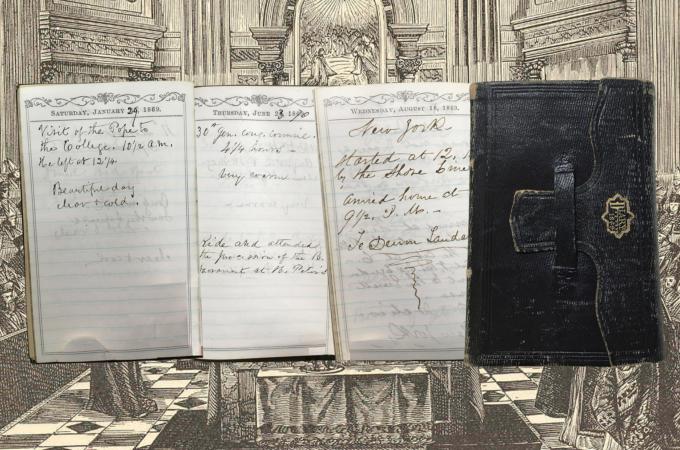The 150th anniversary of the First Vatican Council -- Part II
Last week's From the Archives column discussed the announcement of the First Vatican Council (Vatican I) by Pope Pius IX, his appointment of committees to prepare agendas and schemata in advance of the council, and the sermon delivered by Archbishop John J. Williams of Boston on the eve of his departure for Rome.
Within the archive's collection is a small pocket diary kept by Archbishop Williams during his time away from the archdiocese, beginning the day he left Boston, Thursday, Oct. 19, 1869, until the day of his return, Aug. 17, 1870. The small pocket diary measures 2.5 by 3 inches and contains brief daily entries regarding his location, activities and weather.
Accompanied by Father Alexander Sherwood Healy, the diary traces his journey to Rome, passing through New York, Liverpool, London, Paris, Munich, Trent, and several other cities before arriving on Nov. 27. He made his residence at the American College, where he would stay for the duration of the council.
While in Rome he noted down each session of the council, he was known to have attended all 89 general congregations, and usually continued with the daily weather and events, such as visits to churches, museums, and papal audiences. Regretfully, the diary does not provide insight into his thoughts about the issues under discussion at the sessions, probably because those in attendance were instructed to keep the proceedings secret, nor was he known to have delivered any speeches.
The governance and proceedings of the council were largely set out in an apostolic letter published on Dec. 2, 1869. It stated Pius IX would appoint five cardinals to act as council presidents and reserved for himself the right to propose questions for discussion. Furthermore, it provided for the creation of four committees of 28 members each, responsible for amending schemata. In terms of proceedings, the letter named two types of meetings, the ceremonial solemn processions, and the general congregations, where proposed schemata would be debated and voted upon.
Members were to cast their votes by ballot, indicating whether they were in favor, conditionally in favor, or not in favor. Conditional votes required an explanation of any reservations regarding the schema, which would then be reviewed by the relevant committee and incorporated into a new draft to be submitted for further debate by the general congregation. If it was felt a final draft had been reached, votes were taken by roll call.
The letter also called for the proceedings and discussions to remain secret from the general public, and forbade members from leaving Rome without permission of the Holy Father. A second letter in February 1870 modified the rules, instructing that schemata must first be debated in their entirety before critiquing separate chapters, the call for a vote on schemata could be enacted by a simple majority, and proposed amendments were to be submitted in writing.
The first solemn procession opened the council on Dec. 8, 1869, with about 700 Catholic leaders in attendance, followed by the first general congregation two days later, which selected committee members. The first debates began on Dec. 28, 1869, focusing on a proposed schema regarding the Catholic faith in general, but it was criticized for being too long, technical, and not practical in terms of pastoral ministry. This series of sessions concluded on New Year's Day, 1870, and was followed by a short break.
The sessions resumed on Jan. 10 and continued through Feb. 22. A number of concerns were discussed, including the role of bishops, vacant sees, clerical life, and a universal catechism. Again, a recess followed, allowing committees time to review feedback and revise their respective schema.
The council reconvened on March 18, and, on April 24, unanimously approved the revised schema on the Catholic faith, "Dei Filius." Five days later, discussion of a universal catechism resumed, but soon shifted towards two of the main issues that overshadowed the council -- papal primacy and infallibility.
Both are complicated theological ideas but, in brief, papal primacy refers to the standing of the pope, or Bishop of Rome, over bishops from other dioceses in the Catholic Church. The idea existed because the bishops of Rome are the successors of St. Peter, whom Jesus named as first among the Apostles. Papal Infallibility refers to the pope being free from error when teaching Catholic faith and morals.
Though widely accepted to some degree, both were ill-defined and there was a broad range of support, or lack thereof, among Catholics. Some came to the council in favor of defining these terms to eliminate ambiguities and delineate their role at a practical level, while the opposing view was that both were revealed truths, part of Catholic tradition, and did not require further clarification.
Together the most divisive issues at the council, both had come up in debate since January and continued into July as over 150 members spoke on the subject. On July 18, 1870, the schema "Pastor aeternus" was approved with only two dissenting votes; 61 attendees submitted written protests and were granted permission to depart prior to the solemn session making its implementation.
Vatican I continued through the summer but with many fewer participants, the 89th and final general congregation held on Sept. 1, 1870. The following day, the armies supporting Italian unification invaded the Papal States and Rome surrendered on Sept. 20. One month later, Pius IX suspended the council indefinitely, never to be resumed.
- Thomas Lester is the archivist of the Archdiocese of Boston.



















